Leadership Roles and Context: CEO of Multinational Firm and Coach
VerifiedAdded on 2023/06/10
|9
|2429
|158
Essay
AI Summary
This essay delves into the contrasting yet interconnected worlds of leadership, examining the roles and contexts of CEOs in multinational corporations and sports coaches. The essay begins by exploring the multifaceted responsibilities of a CEO, highlighting the importance of adaptability, decision-making, and stakeholder management. It then transitions to the realm of sports coaching, emphasizing the coach's role in athlete development, ethical conduct, and team motivation. The essay compares and contrasts various leadership styles, such as autocratic, participative, and transformational, as they apply to both contexts. It highlights the significance of communication, conflict management, and the ability to inspire and motivate teams to achieve their objectives. Through examples like Tim Cook and Alex Ferguson, the essay illustrates how leadership styles influence performance. The conclusion underscores the common threads of effective leadership, emphasizing innovation, stakeholder focus, and the importance of selfless dedication in achieving success.
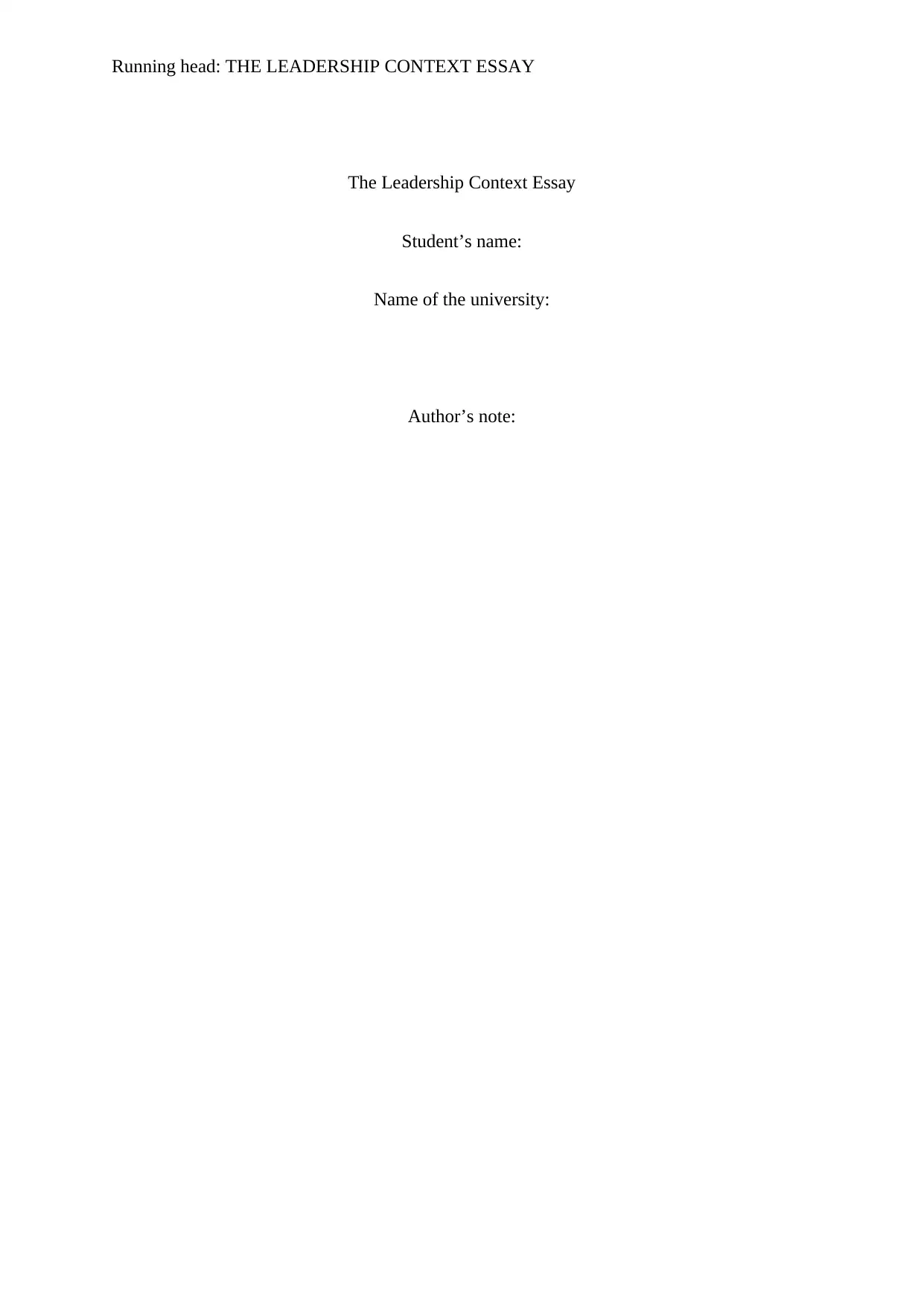
Running head: THE LEADERSHIP CONTEXT ESSAY
The Leadership Context Essay
Student’s name:
Name of the university:
Author’s note:
The Leadership Context Essay
Student’s name:
Name of the university:
Author’s note:
Paraphrase This Document
Need a fresh take? Get an instant paraphrase of this document with our AI Paraphraser
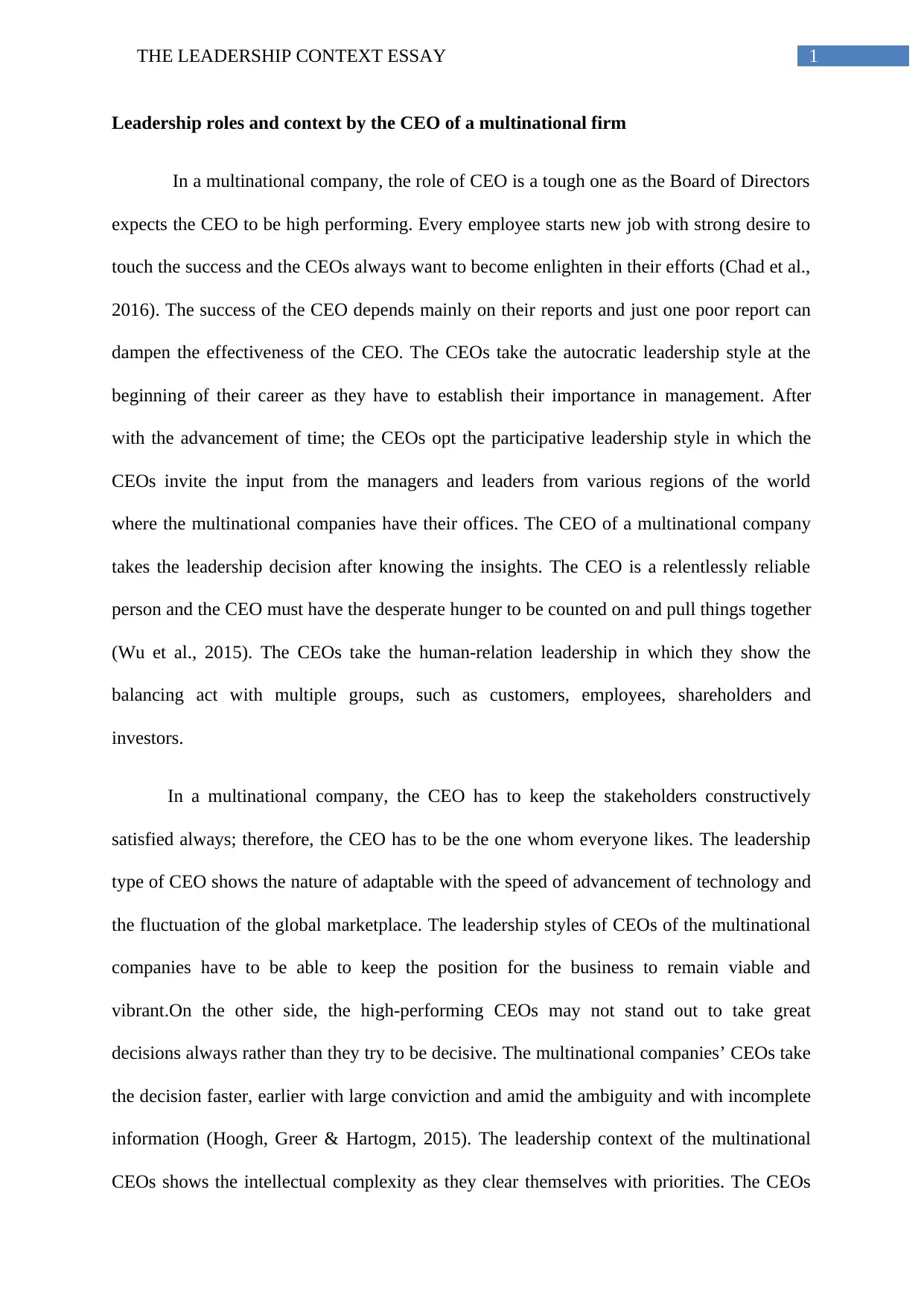
1THE LEADERSHIP CONTEXT ESSAY
Leadership roles and context by the CEO of a multinational firm
In a multinational company, the role of CEO is a tough one as the Board of Directors
expects the CEO to be high performing. Every employee starts new job with strong desire to
touch the success and the CEOs always want to become enlighten in their efforts (Chad et al.,
2016). The success of the CEO depends mainly on their reports and just one poor report can
dampen the effectiveness of the CEO. The CEOs take the autocratic leadership style at the
beginning of their career as they have to establish their importance in management. After
with the advancement of time; the CEOs opt the participative leadership style in which the
CEOs invite the input from the managers and leaders from various regions of the world
where the multinational companies have their offices. The CEO of a multinational company
takes the leadership decision after knowing the insights. The CEO is a relentlessly reliable
person and the CEO must have the desperate hunger to be counted on and pull things together
(Wu et al., 2015). The CEOs take the human-relation leadership in which they show the
balancing act with multiple groups, such as customers, employees, shareholders and
investors.
In a multinational company, the CEO has to keep the stakeholders constructively
satisfied always; therefore, the CEO has to be the one whom everyone likes. The leadership
type of CEO shows the nature of adaptable with the speed of advancement of technology and
the fluctuation of the global marketplace. The leadership styles of CEOs of the multinational
companies have to be able to keep the position for the business to remain viable and
vibrant.On the other side, the high-performing CEOs may not stand out to take great
decisions always rather than they try to be decisive. The multinational companies’ CEOs take
the decision faster, earlier with large conviction and amid the ambiguity and with incomplete
information (Hoogh, Greer & Hartogm, 2015). The leadership context of the multinational
CEOs shows the intellectual complexity as they clear themselves with priorities. The CEOs
Leadership roles and context by the CEO of a multinational firm
In a multinational company, the role of CEO is a tough one as the Board of Directors
expects the CEO to be high performing. Every employee starts new job with strong desire to
touch the success and the CEOs always want to become enlighten in their efforts (Chad et al.,
2016). The success of the CEO depends mainly on their reports and just one poor report can
dampen the effectiveness of the CEO. The CEOs take the autocratic leadership style at the
beginning of their career as they have to establish their importance in management. After
with the advancement of time; the CEOs opt the participative leadership style in which the
CEOs invite the input from the managers and leaders from various regions of the world
where the multinational companies have their offices. The CEO of a multinational company
takes the leadership decision after knowing the insights. The CEO is a relentlessly reliable
person and the CEO must have the desperate hunger to be counted on and pull things together
(Wu et al., 2015). The CEOs take the human-relation leadership in which they show the
balancing act with multiple groups, such as customers, employees, shareholders and
investors.
In a multinational company, the CEO has to keep the stakeholders constructively
satisfied always; therefore, the CEO has to be the one whom everyone likes. The leadership
type of CEO shows the nature of adaptable with the speed of advancement of technology and
the fluctuation of the global marketplace. The leadership styles of CEOs of the multinational
companies have to be able to keep the position for the business to remain viable and
vibrant.On the other side, the high-performing CEOs may not stand out to take great
decisions always rather than they try to be decisive. The multinational companies’ CEOs take
the decision faster, earlier with large conviction and amid the ambiguity and with incomplete
information (Hoogh, Greer & Hartogm, 2015). The leadership context of the multinational
CEOs shows the intellectual complexity as they clear themselves with priorities. The CEOs
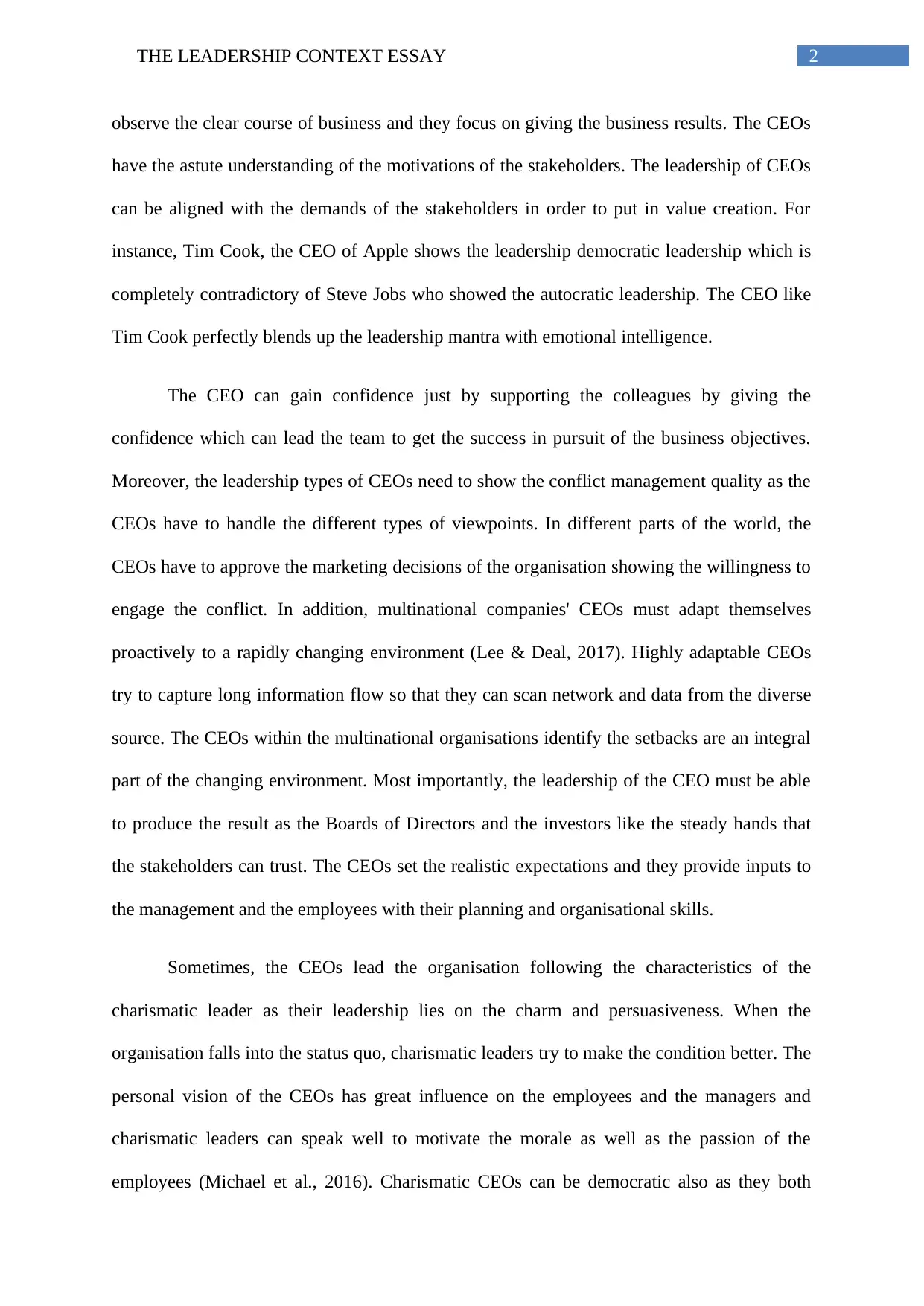
2THE LEADERSHIP CONTEXT ESSAY
observe the clear course of business and they focus on giving the business results. The CEOs
have the astute understanding of the motivations of the stakeholders. The leadership of CEOs
can be aligned with the demands of the stakeholders in order to put in value creation. For
instance, Tim Cook, the CEO of Apple shows the leadership democratic leadership which is
completely contradictory of Steve Jobs who showed the autocratic leadership. The CEO like
Tim Cook perfectly blends up the leadership mantra with emotional intelligence.
The CEO can gain confidence just by supporting the colleagues by giving the
confidence which can lead the team to get the success in pursuit of the business objectives.
Moreover, the leadership types of CEOs need to show the conflict management quality as the
CEOs have to handle the different types of viewpoints. In different parts of the world, the
CEOs have to approve the marketing decisions of the organisation showing the willingness to
engage the conflict. In addition, multinational companies' CEOs must adapt themselves
proactively to a rapidly changing environment (Lee & Deal, 2017). Highly adaptable CEOs
try to capture long information flow so that they can scan network and data from the diverse
source. The CEOs within the multinational organisations identify the setbacks are an integral
part of the changing environment. Most importantly, the leadership of the CEO must be able
to produce the result as the Boards of Directors and the investors like the steady hands that
the stakeholders can trust. The CEOs set the realistic expectations and they provide inputs to
the management and the employees with their planning and organisational skills.
Sometimes, the CEOs lead the organisation following the characteristics of the
charismatic leader as their leadership lies on the charm and persuasiveness. When the
organisation falls into the status quo, charismatic leaders try to make the condition better. The
personal vision of the CEOs has great influence on the employees and the managers and
charismatic leaders can speak well to motivate the morale as well as the passion of the
employees (Michael et al., 2016). Charismatic CEOs can be democratic also as they both
observe the clear course of business and they focus on giving the business results. The CEOs
have the astute understanding of the motivations of the stakeholders. The leadership of CEOs
can be aligned with the demands of the stakeholders in order to put in value creation. For
instance, Tim Cook, the CEO of Apple shows the leadership democratic leadership which is
completely contradictory of Steve Jobs who showed the autocratic leadership. The CEO like
Tim Cook perfectly blends up the leadership mantra with emotional intelligence.
The CEO can gain confidence just by supporting the colleagues by giving the
confidence which can lead the team to get the success in pursuit of the business objectives.
Moreover, the leadership types of CEOs need to show the conflict management quality as the
CEOs have to handle the different types of viewpoints. In different parts of the world, the
CEOs have to approve the marketing decisions of the organisation showing the willingness to
engage the conflict. In addition, multinational companies' CEOs must adapt themselves
proactively to a rapidly changing environment (Lee & Deal, 2017). Highly adaptable CEOs
try to capture long information flow so that they can scan network and data from the diverse
source. The CEOs within the multinational organisations identify the setbacks are an integral
part of the changing environment. Most importantly, the leadership of the CEO must be able
to produce the result as the Boards of Directors and the investors like the steady hands that
the stakeholders can trust. The CEOs set the realistic expectations and they provide inputs to
the management and the employees with their planning and organisational skills.
Sometimes, the CEOs lead the organisation following the characteristics of the
charismatic leader as their leadership lies on the charm and persuasiveness. When the
organisation falls into the status quo, charismatic leaders try to make the condition better. The
personal vision of the CEOs has great influence on the employees and the managers and
charismatic leaders can speak well to motivate the morale as well as the passion of the
employees (Michael et al., 2016). Charismatic CEOs can be democratic also as they both
⊘ This is a preview!⊘
Do you want full access?
Subscribe today to unlock all pages.

Trusted by 1+ million students worldwide
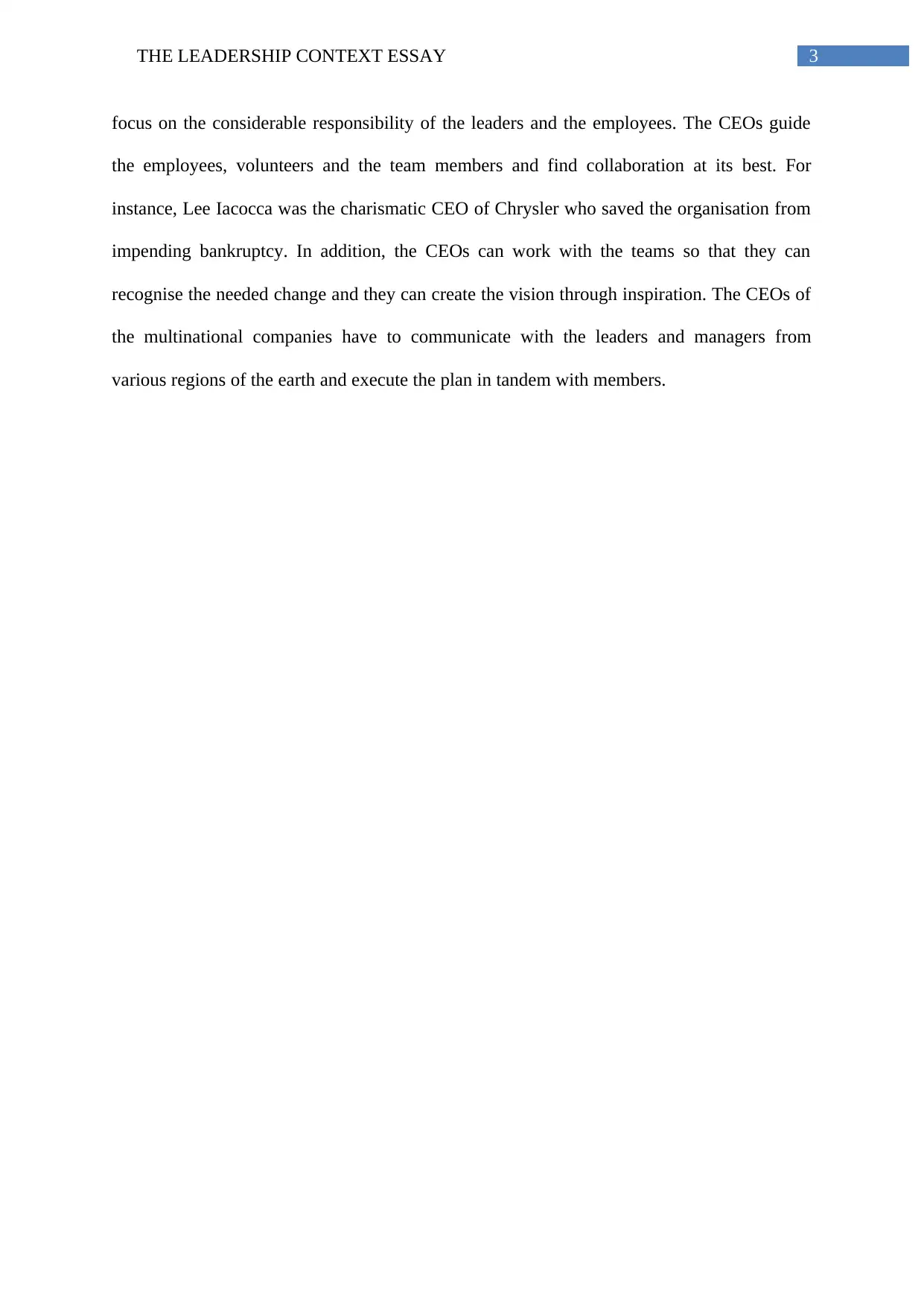
3THE LEADERSHIP CONTEXT ESSAY
focus on the considerable responsibility of the leaders and the employees. The CEOs guide
the employees, volunteers and the team members and find collaboration at its best. For
instance, Lee Iacocca was the charismatic CEO of Chrysler who saved the organisation from
impending bankruptcy. In addition, the CEOs can work with the teams so that they can
recognise the needed change and they can create the vision through inspiration. The CEOs of
the multinational companies have to communicate with the leaders and managers from
various regions of the earth and execute the plan in tandem with members.
focus on the considerable responsibility of the leaders and the employees. The CEOs guide
the employees, volunteers and the team members and find collaboration at its best. For
instance, Lee Iacocca was the charismatic CEO of Chrysler who saved the organisation from
impending bankruptcy. In addition, the CEOs can work with the teams so that they can
recognise the needed change and they can create the vision through inspiration. The CEOs of
the multinational companies have to communicate with the leaders and managers from
various regions of the earth and execute the plan in tandem with members.
Paraphrase This Document
Need a fresh take? Get an instant paraphrase of this document with our AI Paraphraser
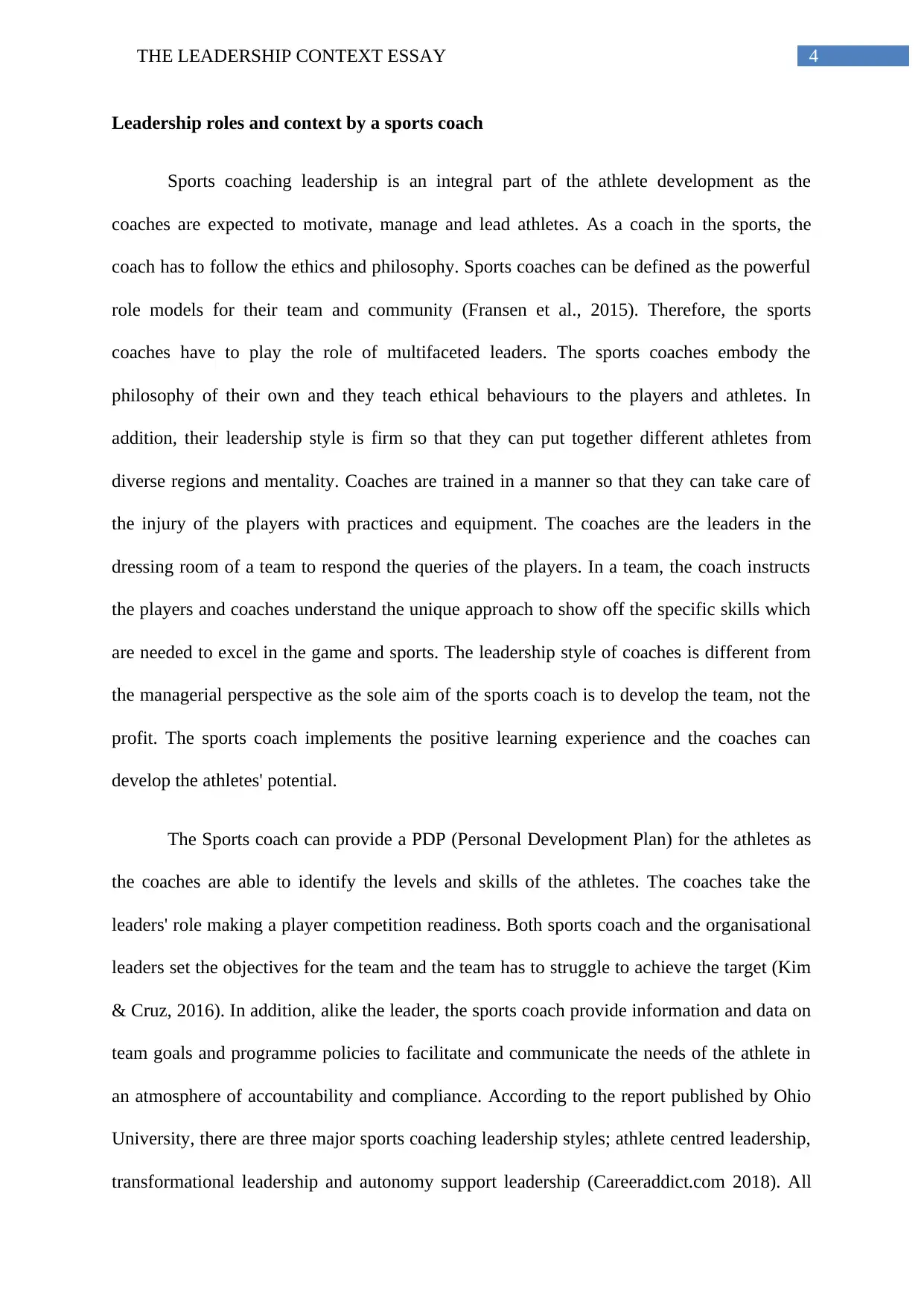
4THE LEADERSHIP CONTEXT ESSAY
Leadership roles and context by a sports coach
Sports coaching leadership is an integral part of the athlete development as the
coaches are expected to motivate, manage and lead athletes. As a coach in the sports, the
coach has to follow the ethics and philosophy. Sports coaches can be defined as the powerful
role models for their team and community (Fransen et al., 2015). Therefore, the sports
coaches have to play the role of multifaceted leaders. The sports coaches embody the
philosophy of their own and they teach ethical behaviours to the players and athletes. In
addition, their leadership style is firm so that they can put together different athletes from
diverse regions and mentality. Coaches are trained in a manner so that they can take care of
the injury of the players with practices and equipment. The coaches are the leaders in the
dressing room of a team to respond the queries of the players. In a team, the coach instructs
the players and coaches understand the unique approach to show off the specific skills which
are needed to excel in the game and sports. The leadership style of coaches is different from
the managerial perspective as the sole aim of the sports coach is to develop the team, not the
profit. The sports coach implements the positive learning experience and the coaches can
develop the athletes' potential.
The Sports coach can provide a PDP (Personal Development Plan) for the athletes as
the coaches are able to identify the levels and skills of the athletes. The coaches take the
leaders' role making a player competition readiness. Both sports coach and the organisational
leaders set the objectives for the team and the team has to struggle to achieve the target (Kim
& Cruz, 2016). In addition, alike the leader, the sports coach provide information and data on
team goals and programme policies to facilitate and communicate the needs of the athlete in
an atmosphere of accountability and compliance. According to the report published by Ohio
University, there are three major sports coaching leadership styles; athlete centred leadership,
transformational leadership and autonomy support leadership (Careeraddict.com 2018). All
Leadership roles and context by a sports coach
Sports coaching leadership is an integral part of the athlete development as the
coaches are expected to motivate, manage and lead athletes. As a coach in the sports, the
coach has to follow the ethics and philosophy. Sports coaches can be defined as the powerful
role models for their team and community (Fransen et al., 2015). Therefore, the sports
coaches have to play the role of multifaceted leaders. The sports coaches embody the
philosophy of their own and they teach ethical behaviours to the players and athletes. In
addition, their leadership style is firm so that they can put together different athletes from
diverse regions and mentality. Coaches are trained in a manner so that they can take care of
the injury of the players with practices and equipment. The coaches are the leaders in the
dressing room of a team to respond the queries of the players. In a team, the coach instructs
the players and coaches understand the unique approach to show off the specific skills which
are needed to excel in the game and sports. The leadership style of coaches is different from
the managerial perspective as the sole aim of the sports coach is to develop the team, not the
profit. The sports coach implements the positive learning experience and the coaches can
develop the athletes' potential.
The Sports coach can provide a PDP (Personal Development Plan) for the athletes as
the coaches are able to identify the levels and skills of the athletes. The coaches take the
leaders' role making a player competition readiness. Both sports coach and the organisational
leaders set the objectives for the team and the team has to struggle to achieve the target (Kim
& Cruz, 2016). In addition, alike the leader, the sports coach provide information and data on
team goals and programme policies to facilitate and communicate the needs of the athlete in
an atmosphere of accountability and compliance. According to the report published by Ohio
University, there are three major sports coaching leadership styles; athlete centred leadership,
transformational leadership and autonomy support leadership (Careeraddict.com 2018). All
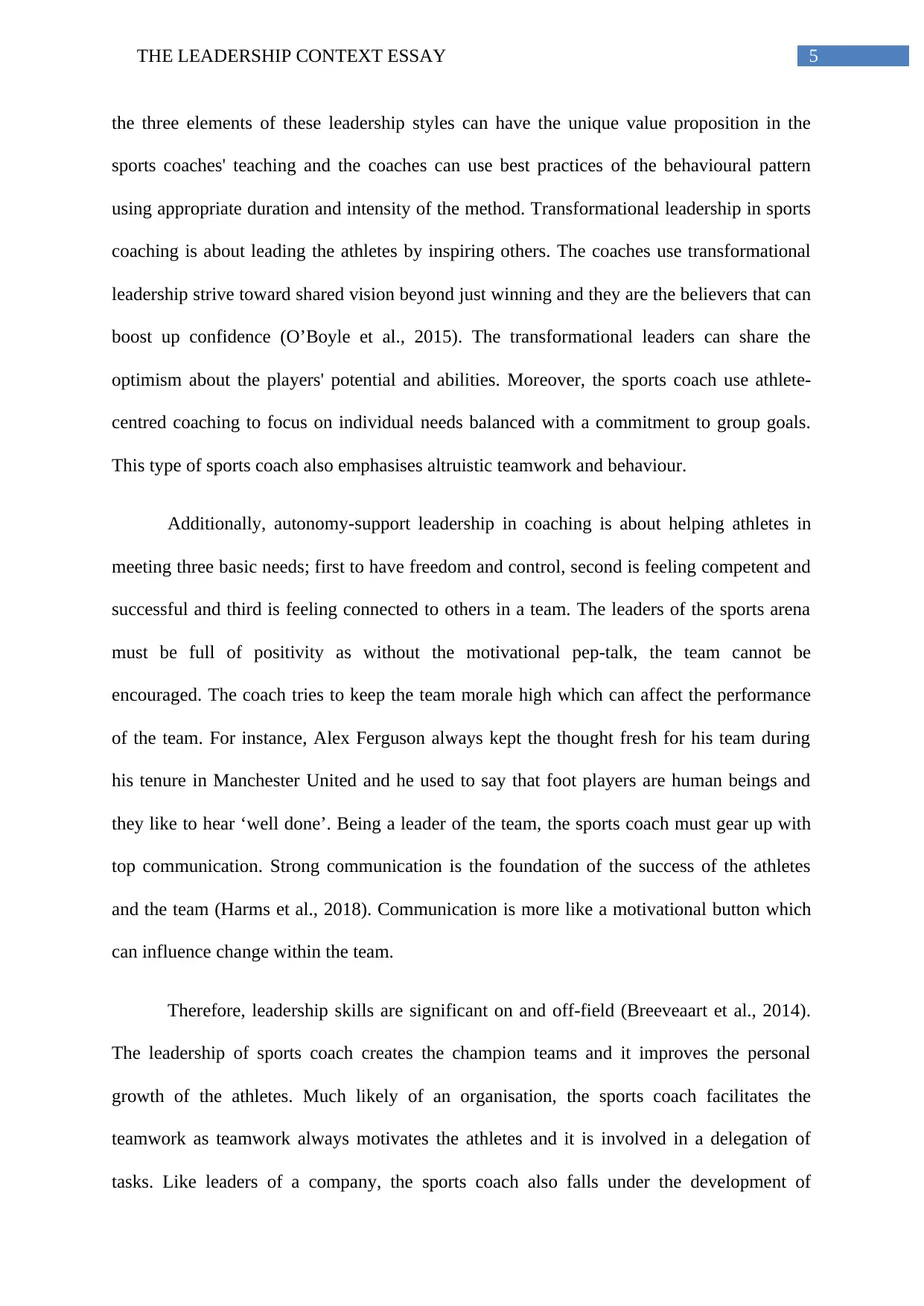
5THE LEADERSHIP CONTEXT ESSAY
the three elements of these leadership styles can have the unique value proposition in the
sports coaches' teaching and the coaches can use best practices of the behavioural pattern
using appropriate duration and intensity of the method. Transformational leadership in sports
coaching is about leading the athletes by inspiring others. The coaches use transformational
leadership strive toward shared vision beyond just winning and they are the believers that can
boost up confidence (O’Boyle et al., 2015). The transformational leaders can share the
optimism about the players' potential and abilities. Moreover, the sports coach use athlete-
centred coaching to focus on individual needs balanced with a commitment to group goals.
This type of sports coach also emphasises altruistic teamwork and behaviour.
Additionally, autonomy-support leadership in coaching is about helping athletes in
meeting three basic needs; first to have freedom and control, second is feeling competent and
successful and third is feeling connected to others in a team. The leaders of the sports arena
must be full of positivity as without the motivational pep-talk, the team cannot be
encouraged. The coach tries to keep the team morale high which can affect the performance
of the team. For instance, Alex Ferguson always kept the thought fresh for his team during
his tenure in Manchester United and he used to say that foot players are human beings and
they like to hear ‘well done’. Being a leader of the team, the sports coach must gear up with
top communication. Strong communication is the foundation of the success of the athletes
and the team (Harms et al., 2018). Communication is more like a motivational button which
can influence change within the team.
Therefore, leadership skills are significant on and off-field (Breeveaart et al., 2014).
The leadership of sports coach creates the champion teams and it improves the personal
growth of the athletes. Much likely of an organisation, the sports coach facilitates the
teamwork as teamwork always motivates the athletes and it is involved in a delegation of
tasks. Like leaders of a company, the sports coach also falls under the development of
the three elements of these leadership styles can have the unique value proposition in the
sports coaches' teaching and the coaches can use best practices of the behavioural pattern
using appropriate duration and intensity of the method. Transformational leadership in sports
coaching is about leading the athletes by inspiring others. The coaches use transformational
leadership strive toward shared vision beyond just winning and they are the believers that can
boost up confidence (O’Boyle et al., 2015). The transformational leaders can share the
optimism about the players' potential and abilities. Moreover, the sports coach use athlete-
centred coaching to focus on individual needs balanced with a commitment to group goals.
This type of sports coach also emphasises altruistic teamwork and behaviour.
Additionally, autonomy-support leadership in coaching is about helping athletes in
meeting three basic needs; first to have freedom and control, second is feeling competent and
successful and third is feeling connected to others in a team. The leaders of the sports arena
must be full of positivity as without the motivational pep-talk, the team cannot be
encouraged. The coach tries to keep the team morale high which can affect the performance
of the team. For instance, Alex Ferguson always kept the thought fresh for his team during
his tenure in Manchester United and he used to say that foot players are human beings and
they like to hear ‘well done’. Being a leader of the team, the sports coach must gear up with
top communication. Strong communication is the foundation of the success of the athletes
and the team (Harms et al., 2018). Communication is more like a motivational button which
can influence change within the team.
Therefore, leadership skills are significant on and off-field (Breeveaart et al., 2014).
The leadership of sports coach creates the champion teams and it improves the personal
growth of the athletes. Much likely of an organisation, the sports coach facilitates the
teamwork as teamwork always motivates the athletes and it is involved in a delegation of
tasks. Like leaders of a company, the sports coach also falls under the development of
⊘ This is a preview!⊘
Do you want full access?
Subscribe today to unlock all pages.

Trusted by 1+ million students worldwide
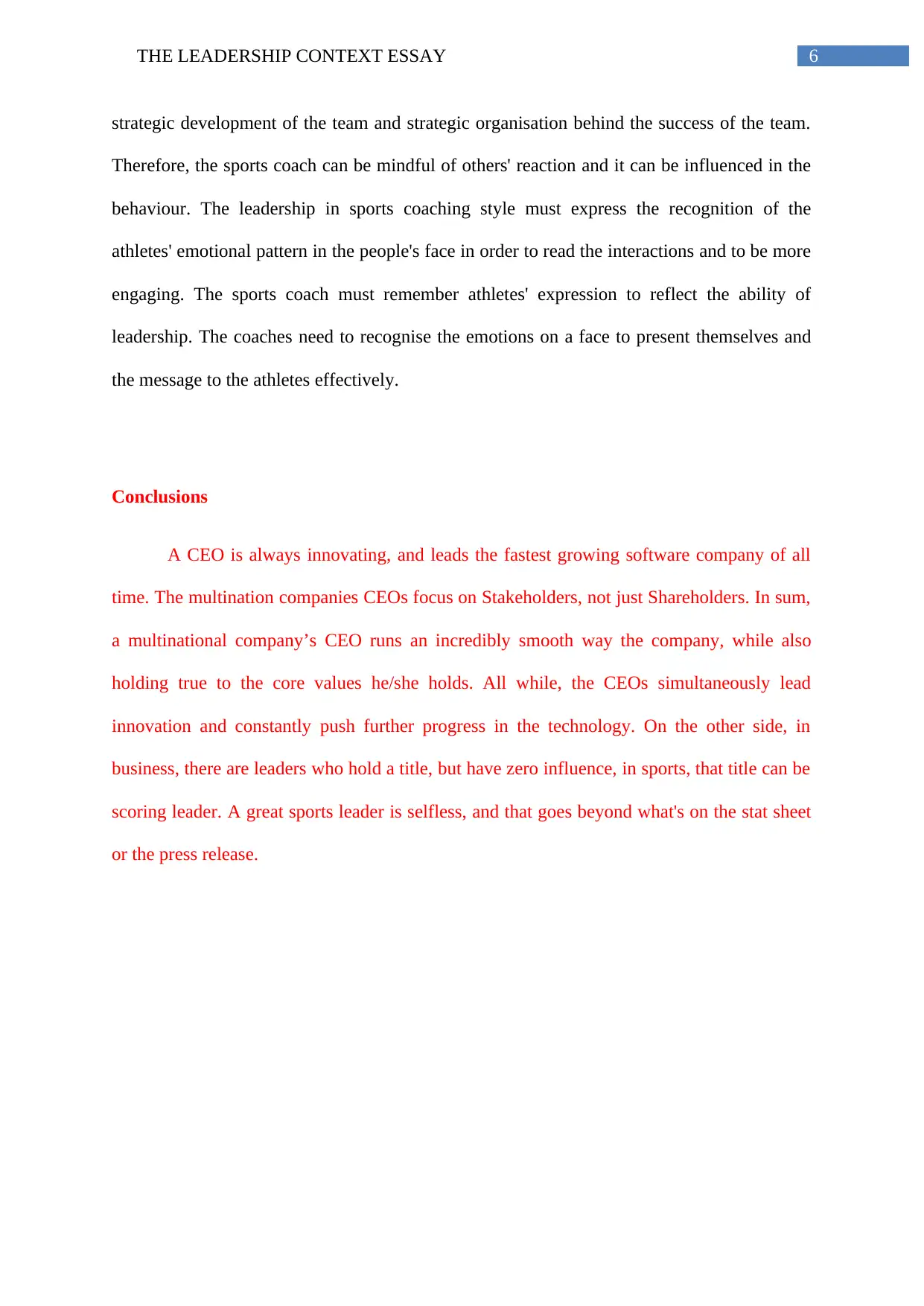
6THE LEADERSHIP CONTEXT ESSAY
strategic development of the team and strategic organisation behind the success of the team.
Therefore, the sports coach can be mindful of others' reaction and it can be influenced in the
behaviour. The leadership in sports coaching style must express the recognition of the
athletes' emotional pattern in the people's face in order to read the interactions and to be more
engaging. The sports coach must remember athletes' expression to reflect the ability of
leadership. The coaches need to recognise the emotions on a face to present themselves and
the message to the athletes effectively.
Conclusions
A CEO is always innovating, and leads the fastest growing software company of all
time. The multination companies CEOs focus on Stakeholders, not just Shareholders. In sum,
a multinational company’s CEO runs an incredibly smooth way the company, while also
holding true to the core values he/she holds. All while, the CEOs simultaneously lead
innovation and constantly push further progress in the technology. On the other side, in
business, there are leaders who hold a title, but have zero influence, in sports, that title can be
scoring leader. A great sports leader is selfless, and that goes beyond what's on the stat sheet
or the press release.
strategic development of the team and strategic organisation behind the success of the team.
Therefore, the sports coach can be mindful of others' reaction and it can be influenced in the
behaviour. The leadership in sports coaching style must express the recognition of the
athletes' emotional pattern in the people's face in order to read the interactions and to be more
engaging. The sports coach must remember athletes' expression to reflect the ability of
leadership. The coaches need to recognise the emotions on a face to present themselves and
the message to the athletes effectively.
Conclusions
A CEO is always innovating, and leads the fastest growing software company of all
time. The multination companies CEOs focus on Stakeholders, not just Shareholders. In sum,
a multinational company’s CEO runs an incredibly smooth way the company, while also
holding true to the core values he/she holds. All while, the CEOs simultaneously lead
innovation and constantly push further progress in the technology. On the other side, in
business, there are leaders who hold a title, but have zero influence, in sports, that title can be
scoring leader. A great sports leader is selfless, and that goes beyond what's on the stat sheet
or the press release.
Paraphrase This Document
Need a fresh take? Get an instant paraphrase of this document with our AI Paraphraser
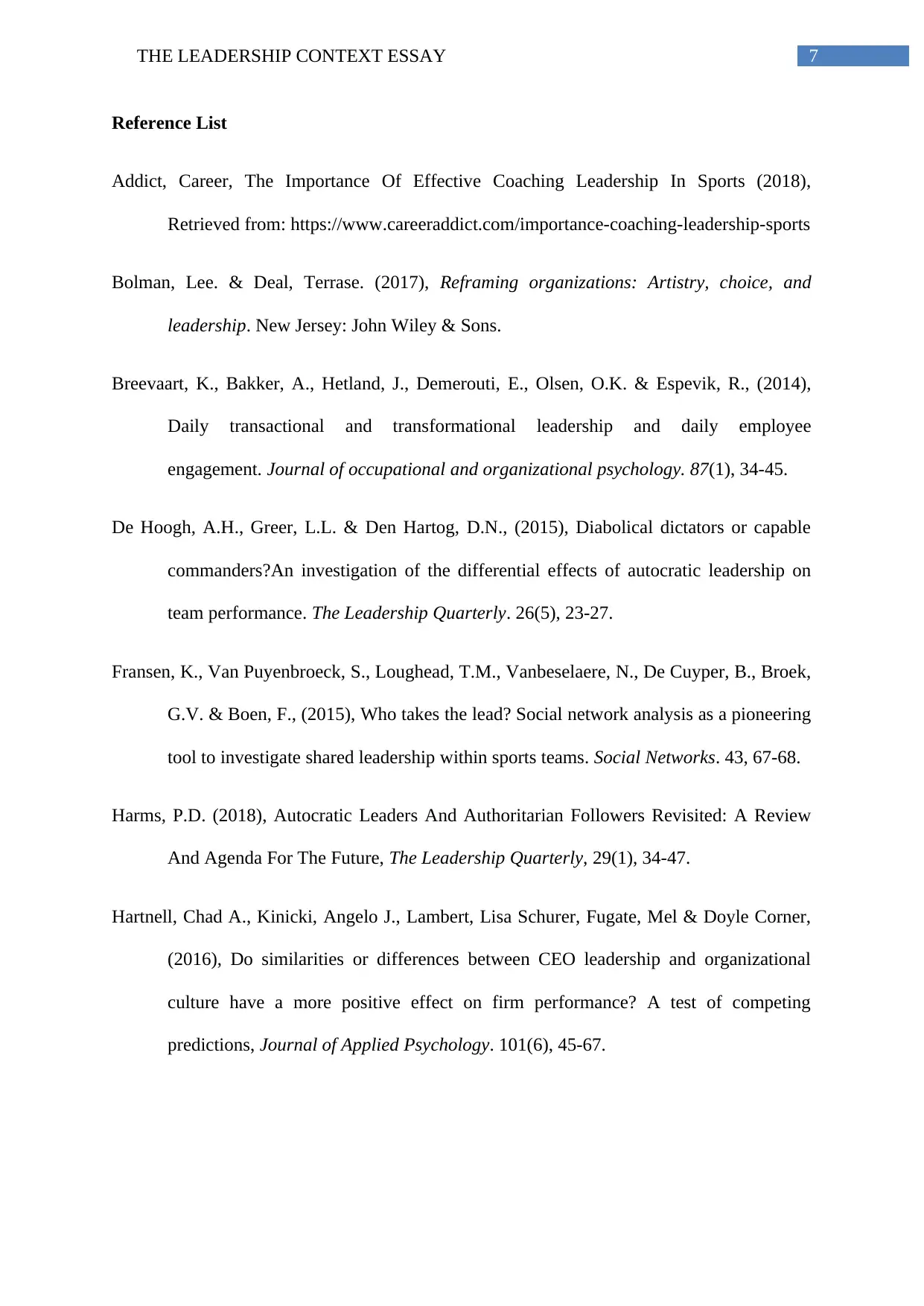
7THE LEADERSHIP CONTEXT ESSAY
Reference List
Addict, Career, The Importance Of Effective Coaching Leadership In Sports (2018),
Retrieved from: https://www.careeraddict.com/importance-coaching-leadership-sports
Bolman, Lee. & Deal, Terrase. (2017), Reframing organizations: Artistry, choice, and
leadership. New Jersey: John Wiley & Sons.
Breevaart, K., Bakker, A., Hetland, J., Demerouti, E., Olsen, O.K. & Espevik, R., (2014),
Daily transactional and transformational leadership and daily employee
engagement. Journal of occupational and organizational psychology. 87(1), 34-45.
De Hoogh, A.H., Greer, L.L. & Den Hartog, D.N., (2015), Diabolical dictators or capable
commanders?An investigation of the differential effects of autocratic leadership on
team performance. The Leadership Quarterly. 26(5), 23-27.
Fransen, K., Van Puyenbroeck, S., Loughead, T.M., Vanbeselaere, N., De Cuyper, B., Broek,
G.V. & Boen, F., (2015), Who takes the lead? Social network analysis as a pioneering
tool to investigate shared leadership within sports teams. Social Networks. 43, 67-68.
Harms, P.D. (2018), Autocratic Leaders And Authoritarian Followers Revisited: A Review
And Agenda For The Future, The Leadership Quarterly, 29(1), 34-47.
Hartnell, Chad A., Kinicki, Angelo J., Lambert, Lisa Schurer, Fugate, Mel & Doyle Corner,
(2016), Do similarities or differences between CEO leadership and organizational
culture have a more positive effect on firm performance? A test of competing
predictions, Journal of Applied Psychology. 101(6), 45-67.
Reference List
Addict, Career, The Importance Of Effective Coaching Leadership In Sports (2018),
Retrieved from: https://www.careeraddict.com/importance-coaching-leadership-sports
Bolman, Lee. & Deal, Terrase. (2017), Reframing organizations: Artistry, choice, and
leadership. New Jersey: John Wiley & Sons.
Breevaart, K., Bakker, A., Hetland, J., Demerouti, E., Olsen, O.K. & Espevik, R., (2014),
Daily transactional and transformational leadership and daily employee
engagement. Journal of occupational and organizational psychology. 87(1), 34-45.
De Hoogh, A.H., Greer, L.L. & Den Hartog, D.N., (2015), Diabolical dictators or capable
commanders?An investigation of the differential effects of autocratic leadership on
team performance. The Leadership Quarterly. 26(5), 23-27.
Fransen, K., Van Puyenbroeck, S., Loughead, T.M., Vanbeselaere, N., De Cuyper, B., Broek,
G.V. & Boen, F., (2015), Who takes the lead? Social network analysis as a pioneering
tool to investigate shared leadership within sports teams. Social Networks. 43, 67-68.
Harms, P.D. (2018), Autocratic Leaders And Authoritarian Followers Revisited: A Review
And Agenda For The Future, The Leadership Quarterly, 29(1), 34-47.
Hartnell, Chad A., Kinicki, Angelo J., Lambert, Lisa Schurer, Fugate, Mel & Doyle Corner,
(2016), Do similarities or differences between CEO leadership and organizational
culture have a more positive effect on firm performance? A test of competing
predictions, Journal of Applied Psychology. 101(6), 45-67.
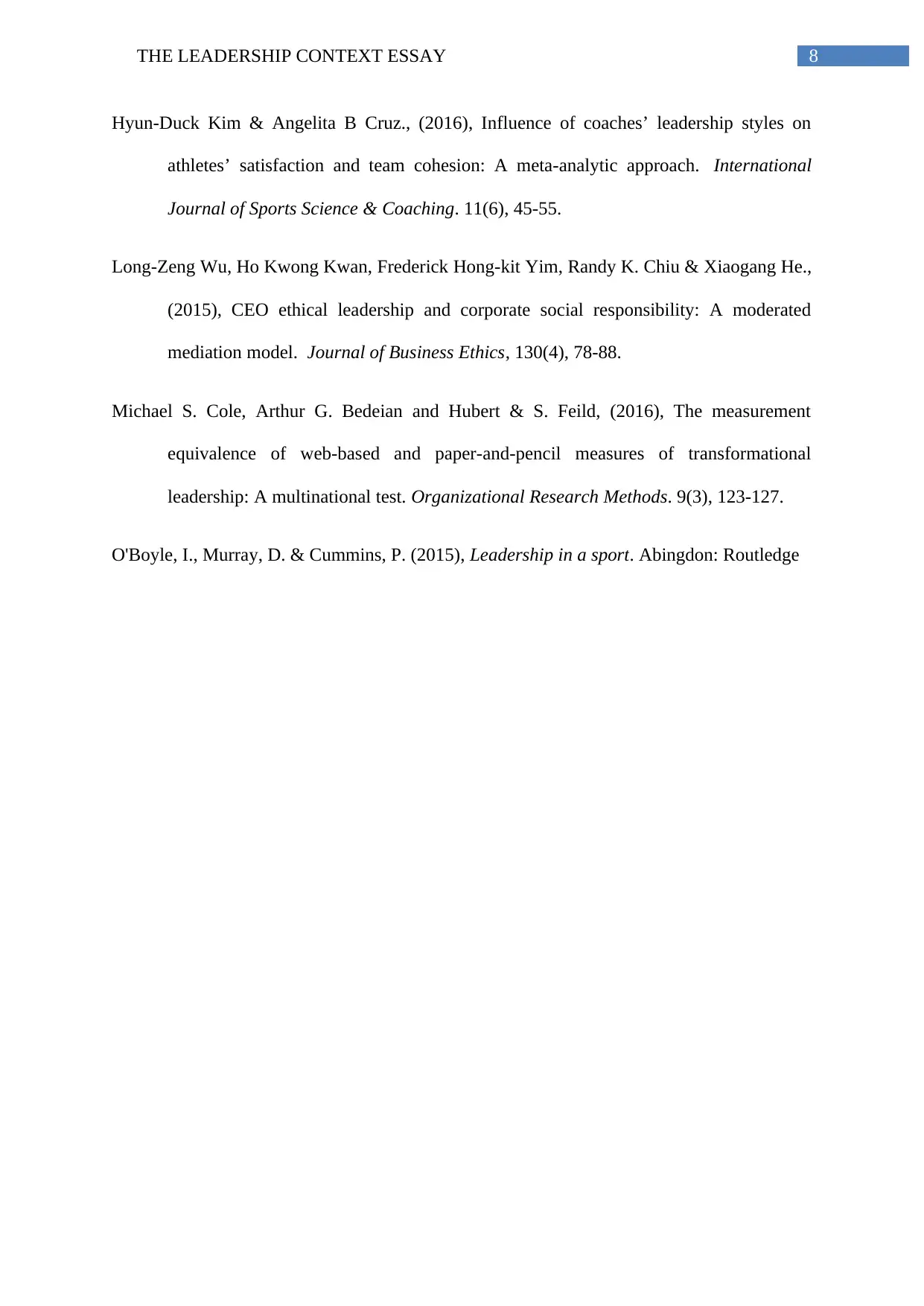
8THE LEADERSHIP CONTEXT ESSAY
Hyun-Duck Kim & Angelita B Cruz., (2016), Influence of coaches’ leadership styles on
athletes’ satisfaction and team cohesion: A meta-analytic approach. International
Journal of Sports Science & Coaching. 11(6), 45-55.
Long-Zeng Wu, Ho Kwong Kwan, Frederick Hong-kit Yim, Randy K. Chiu & Xiaogang He.,
(2015), CEO ethical leadership and corporate social responsibility: A moderated
mediation model. Journal of Business Ethics, 130(4), 78-88.
Michael S. Cole, Arthur G. Bedeian and Hubert & S. Feild, (2016), The measurement
equivalence of web-based and paper-and-pencil measures of transformational
leadership: A multinational test. Organizational Research Methods. 9(3), 123-127.
O'Boyle, I., Murray, D. & Cummins, P. (2015), Leadership in a sport. Abingdon: Routledge
Hyun-Duck Kim & Angelita B Cruz., (2016), Influence of coaches’ leadership styles on
athletes’ satisfaction and team cohesion: A meta-analytic approach. International
Journal of Sports Science & Coaching. 11(6), 45-55.
Long-Zeng Wu, Ho Kwong Kwan, Frederick Hong-kit Yim, Randy K. Chiu & Xiaogang He.,
(2015), CEO ethical leadership and corporate social responsibility: A moderated
mediation model. Journal of Business Ethics, 130(4), 78-88.
Michael S. Cole, Arthur G. Bedeian and Hubert & S. Feild, (2016), The measurement
equivalence of web-based and paper-and-pencil measures of transformational
leadership: A multinational test. Organizational Research Methods. 9(3), 123-127.
O'Boyle, I., Murray, D. & Cummins, P. (2015), Leadership in a sport. Abingdon: Routledge
⊘ This is a preview!⊘
Do you want full access?
Subscribe today to unlock all pages.

Trusted by 1+ million students worldwide
1 out of 9
Related Documents
Your All-in-One AI-Powered Toolkit for Academic Success.
+13062052269
info@desklib.com
Available 24*7 on WhatsApp / Email
![[object Object]](/_next/static/media/star-bottom.7253800d.svg)
Unlock your academic potential
Copyright © 2020–2025 A2Z Services. All Rights Reserved. Developed and managed by ZUCOL.





